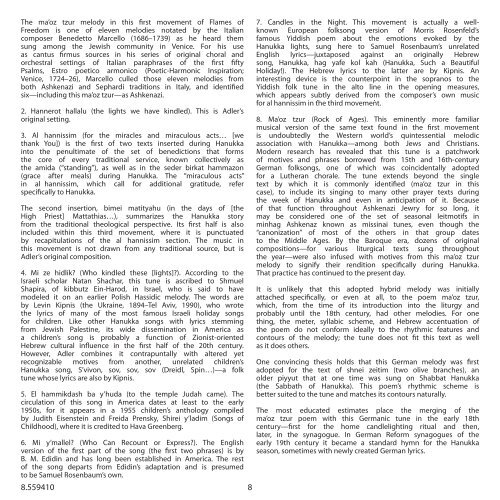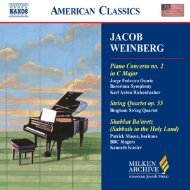Download Liner Notes PDF - Milken Archive of Jewish Music
Download Liner Notes PDF - Milken Archive of Jewish Music
Download Liner Notes PDF - Milken Archive of Jewish Music
- No tags were found...
You also want an ePaper? Increase the reach of your titles
YUMPU automatically turns print PDFs into web optimized ePapers that Google loves.
The ma’oz tzur melody in this first movement <strong>of</strong> Flames <strong>of</strong>Freedom is one <strong>of</strong> eleven melodies notated by the Italiancomposer Benedetto Marcello (1686–1739) as he heard themsung among the <strong>Jewish</strong> community in Venice. For his useas cantus firmus sources in his series <strong>of</strong> original choral andorchestral settings <strong>of</strong> Italian paraphrases <strong>of</strong> the first fiftyPsalms, Estro poetico armonico (Poetic-Harmonic Inspiration;Venice, 1724–26), Marcello culled those eleven melodies fromboth Ashkenazi and Sephardi traditions in Italy, and identifiedsix—including this ma’oz tzur—as Ashkenazi.2. Hannerot hallalu (the lights we have kindled). This is Adler’soriginal setting.3. Al hannissim (for the miracles and miraculous acts… [wethank You]) is the first <strong>of</strong> two texts inserted during Hanukkainto the penultimate <strong>of</strong> the set <strong>of</strong> benedictions that formsthe core <strong>of</strong> every traditional service, known collectively asthe amida (“standing”), as well as in the seder birkat hammazon(grace after meals) during Hanukka. The “miraculous acts”in al hannissim, which call for additional gratitude, referspecifically to Hanukka.The second insertion, bimei matityahu (in the days <strong>of</strong> [theHigh Priest] Mattathias…), summarizes the Hanukka storyfrom the traditional theological perspective. Its first half is alsoincluded within this third movement, where it is punctuatedby recapitulations <strong>of</strong> the al hannissim section. The music inthis movement is not drawn from any traditional source, but isAdler’s original composition.4. Mi ze hidlik? (Who kindled these [lights]?). According to theIsraeli scholar Natan Shachar, this tune is ascribed to ShmuelShapira, <strong>of</strong> kibbutz Ein-Harod, in Israel, who is said to havemodeled it on an earlier Polish Hassidic melody. The words areby Levin Kipnis (the Ukraine, 1894–Tel Aviv, 1990), who wrotethe lyrics <strong>of</strong> many <strong>of</strong> the most famous Israeli holiday songsfor children. Like other Hanukka songs with lyrics stemmingfrom <strong>Jewish</strong> Palestine, its wide dissemination in America asa children’s song is probably a function <strong>of</strong> Zionist-orientedHebrew cultural influence in the first half <strong>of</strong> the 20th century.However, Adler combines it contrapuntally with altered yetrecognizable motives from another, unrelated children’sHanukka song, S’vivon, sov, sov, sov (Dreidl, Spin…)—a folktune whose lyrics are also by Kipnis.5. El hammikdash ba y’huda (to the temple Judah came). Thecirculation <strong>of</strong> this song in America dates at least to the early1950s, for it appears in a 1955 children’s anthology compiledby Judith Eisenstein and Freida Prensky, Shirei y’ladim (Songs <strong>of</strong>Childhood), where it is credited to Hava Greenberg.6. Mi y’mallel? (Who Can Recount or Express?). The Englishversion <strong>of</strong> the first part <strong>of</strong> the song (the first two phrases) is byB. M. Edidin and has long been established in America. The rest<strong>of</strong> the song departs from Edidin’s adaptation and is presumedto be Samuel Rosenbaum’s own.8.559410 87. Candles in the Night. This movement is actually a wellknownEuropean folksong version <strong>of</strong> Morris Rosenfeld’sfamous Yiddish poem about the emotions evoked by theHanukka lights, sung here to Samuel Rosenbaum’s unrelatedEnglish lyrics—juxtaposed against an originally Hebrewsong, Hanukka, hag yafe kol kah (Hanukka, Such a BeautifulHoliday!). The Hebrew lyrics to the latter are by Kipnis. Aninteresting device is the counterpoint in the sopranos to theYiddish folk tune in the alto line in the opening measures,which appears subtly.derived from.the composer’s own musicfor al hannissim in the third movement.8. Ma’oz tzur (Rock <strong>of</strong> Ages). This eminently more familiarmusical version <strong>of</strong> the same text found in the first movementis undoubtedly the Western world’s quintessential melodicassociation with Hanukka—among both Jews and Christians.Modern research has revealed that this tune is a patchwork<strong>of</strong> motives and phrases borrowed from 15th and 16th-centuryGerman folksongs, one <strong>of</strong> which was coincidentally adoptedfor a Lutheran chorale. The tune extends beyond the singletext by which it is commonly identified (ma’oz tzur in thiscase), to include its singing to many other prayer texts duringthe week <strong>of</strong> Hanukka and even in anticipation <strong>of</strong> it. Because<strong>of</strong> that function throughout Ashkenazi Jewry for so long, itmay be considered one <strong>of</strong> the set <strong>of</strong> seasonal leitmotifs inminhag Ashkenaz known as missinai tunes, even though the“canonization” <strong>of</strong> most <strong>of</strong> the others in that group datesto the Middle Ages. By the Baroque era, dozens <strong>of</strong> originalcompositions—for various liturgical texts sung throughoutthe year—were also infused with motives from this ma’oz tzurmelody to signify their rendition specifically during Hanukka.That practice has continued to the present day.It is unlikely that this adopted hybrid melody was initiallyattached specifically, or even at all, to the poem ma’oz tzur,which, from the time <strong>of</strong> its introduction into the liturgy andprobably until the 18th century, had other melodies. For onething, the meter, syllabic scheme, and Hebrew accentuation <strong>of</strong>the poem do not conform ideally to the rhythmic features andcontours <strong>of</strong> the melody; the tune does not fit this text as wellas it does others.One convincing thesis holds that this German melody was firstadopted for the text <strong>of</strong> shnei zeitim (two olive branches), anolder piyyut that at one time was sung on Shabbat Hanukka(the Sabbath <strong>of</strong> Hanukka). This poem’s rhythmic scheme isbetter suited to the tune and matches its contours naturally.The most educated estimates place the merging <strong>of</strong> thema’oz tzur poem with this Germanic tune in the early 18thcentury—first for the home candlelighting ritual and then,later, in the synagogue. In German Reform synagogues <strong>of</strong> theearly 19th century it became a standard hymn for the Hanukkaseason, sometimes with newly created German lyrics.
















